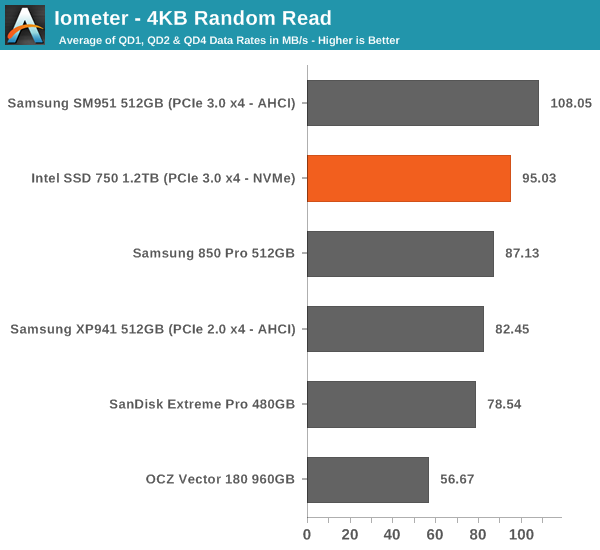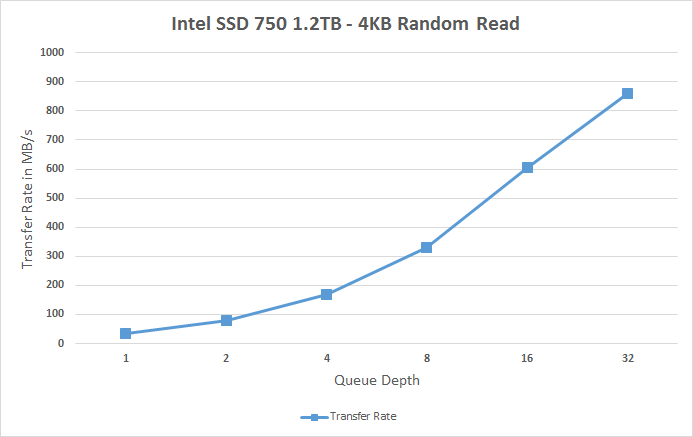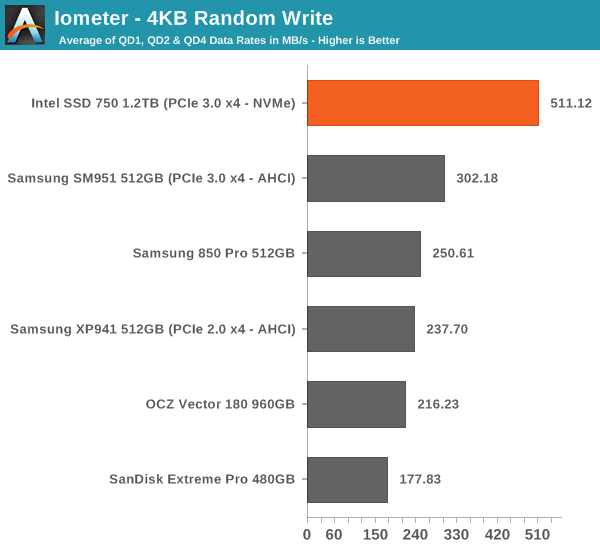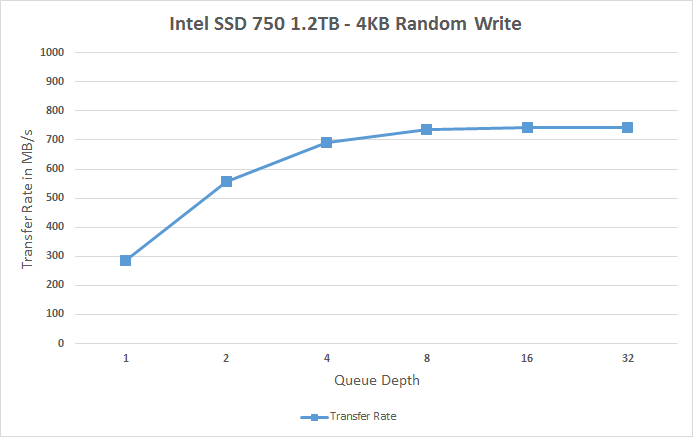Intel SSD 750 PCIe SSD Review: NVMe for the Client
by Kristian Vättö on April 2, 2015 12:00 PM ESTRandom Read Performance
One of the major changes in our 2015 test suite is the synthetic Iometer tests we run. In the past we used to test just one or two queue depths, but real world workloads always contain a mix of different queue depths as shown by our Storage Bench traces. To get the full scope in performance, I'm now testing various queue depths starting from one and going all the way to up to 32. I'm not testing every single queue depth, but merely how the throughput scales with the queue depth. I'm using exponential scaling, meaning that the tested queue depths increase in powers of two (i.e. 1, 2, 4, 8...).
Read tests are conducted on a full drive because that is the only way to ensure that the results are valid (testing with an empty drive can substantially inflate the results and in reality the data you are reading is always valid rather than full of zeros). Each queue depth is tested for three minutes and there is no idle time between the tests.
I'm also reporting two metrics now. For the bar graph, I've taken the average of QD1, QD2 and QD4 data rates, which are the most relevant queue depths for client workloads. This allows for easy and quick comparison between drives. In addition to the bar graph, I'm including a line graph, which shows the performance scaling across all queue depths. To keep the line graphs readable, each drive has its own graph, which can be selected from the drop-down menu.
I'm also plotting power for SATA drives and will be doing the same for PCIe drives as soon as I have the system set up properly. Our datalogging multimeter logs power consumption every second, so I report the average for every queue depth to see how the power scales with the queue depth and performance.

Despite having NVMe, the SSD 750 doesn't bring any improvements to low queue depth random read performance. Theoretically NVMe should be able to improve low QD random read performance because it adds less overhead compared to the AHCI software stack, but ultimately it's the NAND performance that's the bottleneck, although 3D NAND will improve that by a bit.
 |
|||||||||
The performance does scale nicely, though, and at queue depth of 32 the SSD 750 is able to hit over 200K IOPS. It's capable of delivering even more than that because unlike AHCI, NVMe can support more than 32 commands in the queue, but since client workloads rarely go above QD32 I see no point in test higher queue depths just for the sake of high numbers.
Random Write Performance
Write performance is tested in the same way as read performance, except that the drive is in a secure erased state and the LBA span is limited to 16GB. We already test performance consistency separately, so a secure erased drive and limited LBA span ensures that the results here represent peak performance rather than sustained performance.

In random write performance the SSD 750 dominates the other drives. It seems Intel's random IO optimization really shows up here because the SM951 doesn't even come close. Obviously the lower latency of NVMe helps tremendously and since the SSD 750 features full power loss protection it can also cache more data in DRAM without the risk of data loss, which yields substantial performance gains.
 |
|||||||||
The SSD 750 also scales very efficiently and doesn't stop scaling until queue depth of 8. Note how big the difference is at queue depths of 1 and 2 -- for any random write centric workload the SSD 750 is an absolute killer.










132 Comments
View All Comments
knweiss - Thursday, April 2, 2015 - link
According to Semiaccurate the 400 GB drive has "only" 512 MB DRAM.(Unfortunately, ARK hasn't been updated yet so I can't verify.)
eddieobscurant - Thursday, April 2, 2015 - link
You're right it's probably 512mb for the 400gb model and 1gb for the 1.2tb modelAzunia - Thursday, April 2, 2015 - link
In PCPer's review of this drive, they actually talk about the problems of benchmarking this drive. (https://www.youtube.com/watch?v=ubxgTBqgXV8)Seems like some benchmarks like Iometer cannot actually feed the drive, due to being programmed with a single thread. Have you had similar experiences during benchmarking, or is their logic faulty?
Kristian Vättö - Friday, April 3, 2015 - link
I didn't notice anything that would suggest a problem with Iometer's capability of saturating the drive. In fact, Intel provided us Iometer benchmarking guidelines for the review, although they didn't really differ from what I've been doing for a while now.Azunia - Friday, April 3, 2015 - link
Reread their article and it seems like the only problem is the Iometer's Fileserver IOPS Test, which peaks at around 200.000 IOPS, since you don't use that one thats probably the reason why you saw no problem.Gigaplex - Thursday, April 2, 2015 - link
"so if you were to put two SSD 750s in RAID 0 the only option would be to use software RAID. That in turn will render the volume unbootable"It's incredibly easy to use software RAID in Linux on the boot drives. Not all software RAID implementations are as limiting as Windows.
PubFiction - Friday, April 3, 2015 - link
"For better readability, I now provide bar graphs with the first one being an average IOPS of the last 400 seconds and the second graph displaying the standard deviation during the same period"lol why not just portray standard deviation as error bars like they are supposed to be shown. Kudos for being one of the few sites to recognize this but what a convoluted senseless way of showing them.
Chloiber - Friday, April 3, 2015 - link
I think the practical tests of many other reviews show that the normal consumer has absolutely no benefit (except being able to copy files faster) from such an SSD. We have reached the peak a long time ago. SSDs are not the limiting factor anymore.Still, it's great to see that we finally again major improvements. It was always sad that all SSDs got limited by the interface. This was the case with SATA 2, it's the case with SATA 3.
akdj - Friday, April 3, 2015 - link
Thanks for sharing KristianQuery about the thorough put using these on external Thunderbolt docks and PCIe 'decks' (several new third party drive and GPU enclosires experimenting with the latter ...and adding powerful desktop cards {GPU} etc) ... Would there still be the 'bottle neck' (not that SLI nor Crossfire with the exception of the MacPro and how the two AMDs work together--would be a concern in OS X but Windows motherboards...) if you were to utilize the TBolt headers to the PCIe lane-->CPU? These seem like a better idea than external video cards for what I'm Doing on the rMBPs. The GPUs are quick enough, especially in tandem with the IrisPro and its ability to 'calculate' ;) -- but a 2.4GB twin card RAID external box with a 'one cord' plug hot or cold would be SWEEET,
wyewye - Friday, April 3, 2015 - link
Kristian: test with QD128, moron, its NVM.Anandtech becomes more and more idiotic: poor articles and crappy hosting, you have to real pages multiple times to access anything.
Go look at TSSDreview for a competent review.